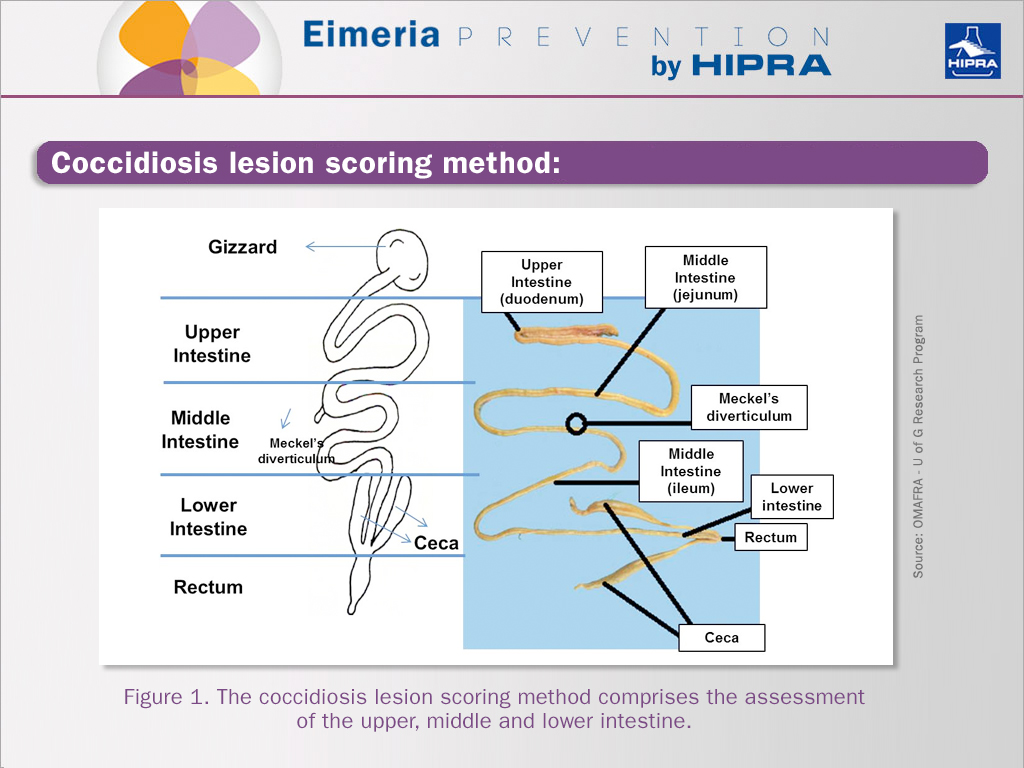When decisions concerning the prevention or control of coccidiosis in poultry are based on the subjective scoring of macroscopic lesions, observed in the gut of a number of birds in a flock, several factors affecting the method should be considered. Proper selection of birds, a careful sampling procedure and sample handling along with an accurate judgment of lesions, are some of the most important methodological indicators for success in lesion scoring during a flock inspection.
1. Selection of the right birds in the right number:
Before necropsy, it is essential to check the history of vaccinations, treatments (anticoccidials in particular) and previous diagnoses of the flock to be sampled.
It has been shown that the existence of gut lesions is not necessarily accompanied by clinical signs of coccidiosis in poultry (Williams et al., 2000).
In fact, the score that has been used for decades was developed in naive birds (Johnson et al., 1970). However, it has been shown that immunized birds may display lesions and high oocyst counts, with no growth retardation or clinically overt disease.
In these cases the lesions are of no economic significance.
As for the number of birds to be examined, it is necessary to seek the right balance between the need to evaluate a representative sample of the batch of birds, and the willingness of the farmer to provide enough birds. Generally, a total of 5 to10 broilers, 25-35-days old, from each house would be reasonable.
These birds should be of the average weight of the batch, and be alive at the time of sampling, not debilitated or fasted.
2. Sampling:
As previously mentioned, it is crucial that birds examined for gross lesions (at least 5 per batch), are alive and within the appropriate age range.
If multiple groups are inspected, it is better to sacrifice one group and then another to reduce post-mortem artifacts.
It is equally important that, as far as possible, the inspections are always carried out by the same person who evaluates the different batches of birds coming from the same farm.
This is mainly because their experience enables them to reduce the variation inherent in the scoring system.
The intestine is the first organ to decompose after death.
Postmortem changes negatively influence the assessment of pathological changes in the gut. Make the sacrifice humanely with the least possible stress.
The preferred euthanasia method on the farm is generally cervical dislocation.
This should be carried out by trained staff because if not done quickly and effectively, it can inflict pain and distress. Sacrifice by carbon dioxide inhalation is another valid alternative, if it is available.
3. Sample handling:
To complete the inspection in a systematic way, consider the four segments of the intestine that are shown in Figure 1. Do not expose the inner surface of the intestine until you have inspected the outer wall.
It is important to record any change in thickness, colour or presence of spots that may be indicative of injury.
Expose the inside of the digestive system including the gizzard, proventriculus and cloaca. Do it using a different scissors and forceps kit for each group of animals.
Observe and describe the content found (amount and appearance), as well as any other signs that catches your attention. Inflammation of the intestine can sometimes be identified immediately after cutting the wall longitudinally, as it tends to fall back on itself.
This only happens when it belongs to a bird that has been recently sacrificed. List all the lesions observed, their exact location, colour, appearance, distribution, shape, etc. Whenever possible, take photos of the lesions found.
There are seven Eimeria species that are responsible for avian coccidiosis, 5 of which cause the disease in broilers: E. acervulina, E. mitis, E. tenella, E. maxima and E. praecox.
Finally, close collaboration between the veterinarian and the farm staff is crucial to avoid possible biases of the method, or the over-interpretation of the lesions found.
The availability of detailed information on health management of the flock, and the right amount of suitable birds for inspection will be very important, before making decisions on the control of coccidiosis based on the results of inspections and lesion scoring.
REFERENCES:
- Williams R.B., Catchpole J., 2000. A new protocol for a challenge test to assess the efficacy of live anticoccidial vaccines for chickens. Vaccine 18(13): 1178-85.
- Johnson J., Reid W.M., 1970. Anticoccidial drugs: lesion scoring techniques in battery and floor-pen experiments with chickens. Exp. Parasitology 28(1): 30-6.




